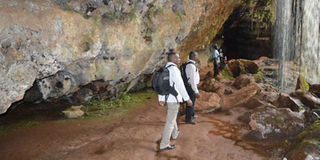Paradise Lost: A hidden gem of prehistoric artefacts

Visitors view a waterfall from a cave at Paradise Lost park in Kiambu. The caves are estimated to be more than 2.5 million years old. PHOTO | ERIC WAINAINA | NATION MEDIA GROUP
What you need to know:
- Perhaps the most popular attraction is a labyrinth of caves carved from the rocks by the waters of River Gichi. The entrance is screened by a spectacular waterfall.
- British colonial authorities tortured Mau Mau freedom fighters in caves.
Paradise Lost is among the few places close to the city that offer a variety of attractions.
It is sandwiched by coffee farms, and is just 10 kilometres from Nairobi city centre.
One can enjoy nature trails, bird watching, horse and camel rides, water sports, exploration of caves, fishing, catering and camping.
It is one place a visitor is likely see some of the rarest central highland bird species, especially in the morning.
Visitors can enjoy guided boat rides in an expansive dam. Fishing is also available.
Other activities include picnics and camping.
Within Paradise Lost is Hyde Park, which has an open bar. Visitors can enjoy a panoramic view of the natural waterfalls and the dam as boats crisscross the water.
The trail is exciting for nature lovers since one gets to explore indigenous and exotic trees.
But perhaps the most popular attraction is a labyrinth of caves carved from the rocks by the waters of River Gichi. The entrance is screened by a spectacular waterfall.
The caves are estimated to be 2.5 million years old. Obsidian rock artefacts from the late Stone Age were found here.
The caves are believed to stretch from the park to Ngecha in Limuru, more than 20km away.
Mukami Kimathi, the widow of freedom fighter Dedan Kimathi, says she and others used to hide in the caves during the fight for independence.
She says that colonial authorities used the caves to torture Mau Mau freedom fighters.
Park manager Tiobatih Mugira says the caves are unique in that they could be the only ones on the planet to run behind a waterfall.
Mr Mugira says that fossils have been found in the caves, suggesting that the early man may have lived here.
“There definitely are other items in the caves which have not been found because the place has not been fully explored,” he says.
There are cultural sites and beautiful waterfall scenery for photography.
The caves have also proved to be ideal places for shooting movies. They are thronged by musicians and actors.
The park is on a 54-acre piece of land and can host up to 2,000 people and 400 cars.
Gate entry fee is only Sh300. Camping overnight is Sh600 per person. One is provided with a tent, mattress, blanket, fire and is assured of security.
Campers are allowed to carry food and drinks. A group can carry a goat for slaughter, for example.
The camp establishment provides a jiko for barbecue.




